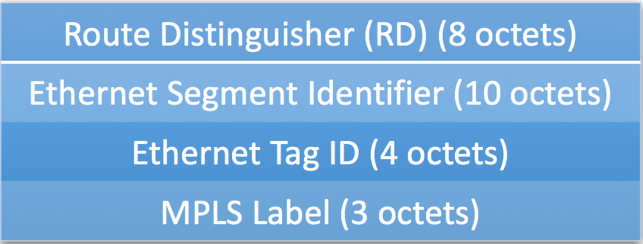Type 1 advertisements are used for two distinct functions – Fast Convergence and Aliasing. EVPN Fast Convergence allows PE devices to change the next-hop adjacencies for all MAC addresses associated with a particular Ethernet Segment. EVPN aliasing allows traffic to be balanced across multiple egress points.
Type 1 routes are only advertised if Ethernet Segment Identifier is set to non-zero value, meaning that Type 1 routes are only originate for multi-homed sites.
Please refer to the following cheatsheet if you are not familiar with EVPN Terminology.
In the following example, Type 1 routes will be advertised by both PE1 and PE5 for CE5 Ethernet Segment. PE5 will not advertise Type 1 for CE4’s Segment, as CE4 is single-homed.

The format of Type 1 Route as described in RFC 7432 is shown below:

PE5’s configuration for CE5 site in Juniper format:
ge-0/0/2 {
flexible-vlan-tagging;
encapsulation flexible-ethernet-services;
esi {
00:00:00:00:00:00:10:00:00:05;
all-active;
}
unit 100 {
encapsulation vlan-bridge;
vlan-id 100;
}
}
The following capture shows Type 1 Ethernet Auto Discover (A-D) route used for Fast Convergence and was taken on PE5. Please note that Ethernet TAG is set to MAX-ET (FFFF:FFF) and MPLS label is the NLRI is set to 0. Extended Community attribute carrying the actual MPLS label is included in the route. Refer to section 8.2.1 of RFC 7432 for more information.
Path Attribute - MP_REACH_NLRI
...
Network layer reachability information (27 bytes)
EVPN NLRI: Ethernet AD Route
AFI: Ethernet AD Route (1)
Length: 25
Route Distinguisher: 0001780002050000 (120.0.2.5:0)
ESI: 00 00 00 00 00 10 00 00 05
ESI Type: ESI 9 bytes value (0)
ESI 9 bytes value: 00 00 00 00 00 10 00 00 05
Ethernet Tag ID: 4294967295 (FFFF:FFFF)
MPLS Label Stack: 0 (bottom)
Path Attribute - EXTENDED_COMMUNITIES
...
Carried extended communities: (2 communities)
Community Transitive Two-Octet AS Route Target: 100:100
Community type high: Transitive Two-Octet AS (0x00)
Subtype as2: Route Target (0x02)
Two octets AS specific: 100
Four octets AN specific: 100
Community Transitive EVPN ESI MPLS Label: All active redundancy
Label: 315232
Community type high: Transitive EVPN (0x06)
Subtype evpn: ESI MPLS Label (0x01)
.... ...0 = Single active bit: All-Active redundancy
Two octets Value specific: 0x0000
MPLS Label: 315232
The following Type 1 route is used for Aliasing.
RFC allows per <ESI, Ethernet Tag ID> or per <ESI> advertisements for a given MAC-VRF. MPLS label provided in this advertisement is used for known unicast load-balancing as described in Section 14 of RFC 7432.
The following Wireshark capture of Type 1 route was taken on PE5’s MPLS network-facing interface. Notice the Ethernet Tag value – router is using per <ESI> granularity by setting Ethernet TAG ID to 0. Refer to section 8.4.1 of RFC 7432 for more information.
Path Attribute - MP_REACH_NLRI ... Network layer reachability information (62 bytes) EVPN NLRI: Ethernet AD Route AFI: Ethernet AD Route (1) Length: 25 Route Distinguisher: 0001780002050064 (120.0.2.5:100) ESI: 00 00 00 00 00 10 00 00 05 ESI Type: ESI 9 bytes value (0) ESI 9 bytes value: 00 00 00 00 00 10 00 00 05 Ethernet Tag ID: 0 MPLS Label Stack: 315168 (bottom)
Advertised Type 1 routes as observed on PE1:
root@PE1 > show route advertising-protocol bgp 120.0.1.1 extensive * 1:120.0.2.1:100::10000005::0/304 AD/EVI (1 entry, 1 announced) BGP group IBGP-RR type Internal Route Distinguisher: 120.0.2.1:100 Route Label: 320576 Nexthop: Self Flags: Nexthop Change Localpref: 100 AS path: [100] I Communities: target:100:100 * 1:120.0.2.1:0::10000005::FFFF:FFFF/304 AD/ESI (1 entry, 1 announced) BGP group IBGP-RR type Internal Route Distinguisher: 120.0.2.1:0 Nexthop: Self Flags: Nexthop Change Localpref: 100 AS path: [100] I Communities: target:100:100 esi-label:all-active (label 320656)
Advertised Type 1 route as observed on PE5:
root@PE5>show route advertising-protocol bgp 120.0.1.1 extensive * 1:120.0.2.5:100::10000005::0/304 AD/EVI (1 entry, 1 announced) BGP group IBGP-RR type Internal Route Distinguisher: 120.0.2.5:100 Route Label: 315168 Nexthop: Self Flags: Nexthop Change Localpref: 100 AS path: [100] I Communities: target:100:100 * 1:120.0.2.5:0::10000005::FFFF:FFFF/304 AD/ESI (1 entry, 1 announced) BGP group IBGP-RR type Internal Route Distinguisher: 120.0.2.5:0 Nexthop: Self Flags: Nexthop Change Localpref: 100 AS path: [100] I Communities: target:100:100 esi-label:all-active (label 315232)
EVPN Instance information captured on PE devices:
PE1 root@PE1> show evpn instance extensive … ESI: 00:00:00:00:00:00:10:00:00:05 Status: Resolved by IFL ge-0/0/2.100 Local interface: ge-0/0/2.100, Status: Up/Forwarding Number of remote PEs connected: 1 Remote PE MAC label Aliasing label Mode 120.0.2.5 0 315168 all-active Designated forwarder: 120.0.2.1 Backup forwarder: 120.0.2.5 Last designated forwarder update: Apr 04 15:43:15 Advertised MAC label: 320576 Advertised aliasing label: 320576 Advertised split horizon label: 320656 PE5 ESI: 00:00:00:00:00:00:10:00:00:05 Status: Resolved by IFL ge-0/0/2.100 Local interface: ge-0/0/2.100, Status: Up/Forwarding Number of remote PEs connected: 1 Remote PE MAC label Aliasing label Mode 120.0.2.1 320576 320576 all-active Designated forwarder: 120.0.2.1 Backup forwarder: 120.0.2.5 Last designated forwarder update: Apr 04 15:43:23 Advertised MAC label: 315168 Advertised aliasing label: 315168 Advertised split horizon label: 315232 PE2 (remote PE not show on the diagram. No direct connection to CE5) Number of ethernet segments: 1 ESI: 00:00:00:00:00:00:10:00:00:05 Status: Unresolved Number of remote PEs connected: 2 Remote PE MAC label Aliasing label Mode 120.0.2.1 320576 320576 all-active 120.0.2.5 0 315168 all-active
Control Plane Wireshark capture can be downloaded from GitHub. Please note that MPLS label values are assigned dynamically and might be different:
For more information on EVPN, please refer to our other articles on this topic:
